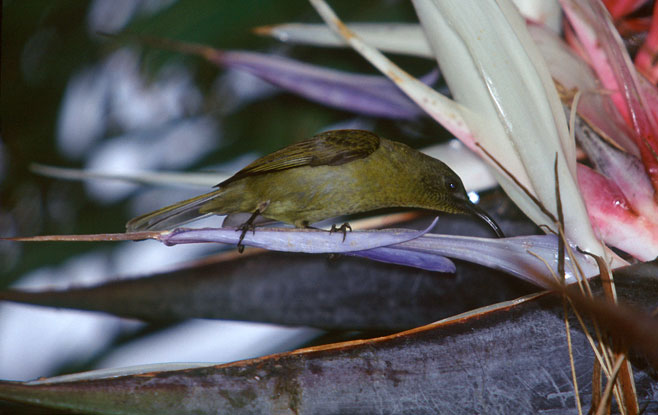Strelitzia nicolai (Natal wild banana)
Life
> eukaryotes >
Archaeoplastida >
Chloroplastida
>
Charophyta > Streptophytina > Plantae (land plants)
> Tracheophyta (vascular plants) > Euphyllophyta > Lignophyta (woody plants)
> Spermatophyta (seed plants) > Angiospermae (flowering
plants) > Monocotyledons > Order: Zingiberales
> Family: Strelitziaceae > Genus:
Strelitzia
Identification
A large tree-like strelitzia, growing to 12 m
tall.
Of the three tree-like strelitzias found in
southern Africa, Strelitzia nicolai is distinguished by
usually having blue, not white petals (thus distinguishing is from
Strelitzia alba although very
occasionally petals can be white in S. nicolai) and by having
a compound flowerhead (one flowerhead arising from another; the
other two species have a simple flowerhead). Note that it is
the arrow-like structure of a Strelitzia flower that consists
of two petals (with style and stamens running between) while the
three large, erect, showy petal-like structures are actually sepals
- these sepals are white in all three species of tree-like
strelitzias. There is a third petal that is inconspicuous.
The fruit is a 3-lobed, dehiscent woody
capsule. The seed is black with an orange, woolly aril.
Origin of name
This species is named after Emperor Nicholas of
Russia. Evidently, a tree of this species was cultivated in the
Imperial Gardens of St Petersburg (recorded as flowering in 1858)
and was recognised as a new species (Palmer & Pitman 1972).
Distribution and habitat
Occurs in coastal dune and forest vegetation,
as well as inland forests, along the east coast of southern Africa
from just south of East London in the Eastern Cape, through
KwaZulu-Natal to southern Mozambique.
Ecological interactions
 |
|
An Eastern olive sunbird (Cyanomitra
olivacea) taking nectar from a flower of Strelitzia nicolai
on the Wild Coast, Eastern Cape, South Africa. [photo
Colin Paterson-Jones ©]
|
- Pollinated by, and a source of nectar for:
- Soft portions of flowers are eaten by:
- Fruits/seeds are eaten by:
- Used as a nesting site by:
Uses by humans
-
Seed capsules contain large black seeds with orange, oily
arils. Seeds are ground into a flour, which is mixed with water and made into a
fritter. The arils are pushed into the fritter and it is then baked over coals
and then eaten. It is evidently a filling meal but not particularly tasty (van
Wyk and Gericke 2000).
-
According to Palmer & Pitman (1972): "Zulus
use the spathes as penis boxes". Somehow I doubt this is still
practiced.
-
The leaves are used for lining damp corn
pits.
Publications
- Palgrave, K.C. and Palgrave, M.C. 2002. Trees of Southern Africa.
3rd Edition. Struik Publishers, Cape Town.
- Palmer, E. and Pitman, N. 1972. Trees of Southern Africa covering all
known indigenous species in the Republic of South Africa, South-West Africa,
Botswana, Lesotho and Swaziland. Volume 1. A.A. Balkema, Cape
Town.
- van Wyk, B.-E. & Gericke, N. 2000. People's
Plants. A Guide to Useful Plants of Southern Africa. Briza Publications,
Pretoria.
Text by Hamish Robertson |
